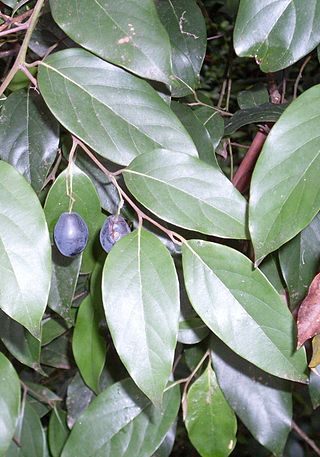
Cryptocarya rigida, commonly known as rose maple, southern maple, rose walnut, pigeonberry ash, forest maple or brown beech, is a species of flowering plant in the family Lauraceae and is endemic to eastern Australia. It is a shrub or small tree with lance-shaped to egg-shaped leaves, creamy green flowers, and elliptic black drupes.

Pomaderris aspera, commonly known as hazel pomaderris, is a species of flowering plant in the family Rhamnaceae and is endemic to south-eastern Australia. It is a shrub or small tree with elliptic to lance-shaped or egg-shaped leaves and greenish-yellow flowers.

Pomaderris intermedia, commonly known as lemon dogwood, is a species of flowering plant in the family Rhamnaceae and is endemic to south-eastern Australia. It is a shrub with hairy stems, elliptic to egg-shaped leaves, and clusters of yellow flowers.

Baeckea brevifolia is a species of flowering plant in the family Myrtaceae and is endemic to south-eastern New South Wales. It is a shrub with narrow egg-shaped to oblong leaves and white to pink flowers with nine to fifteen stamens.
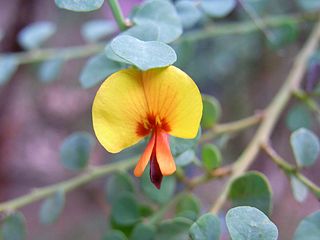
Bossiaea rhombifolia, is a species of flowering plant in the family Fabaceae and is endemic to eastern Australia. It is an erect, glabrous shrub with diamond-shaped, more or less round or broadly egg-shaped leaves, and yellow and red or pinkish flowers.
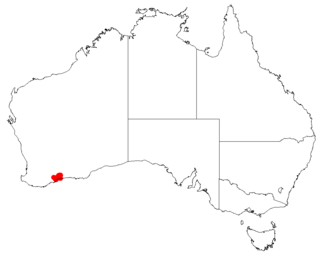
Persoonia dillwynioides, commonly known as Fitzgerald persoonia, is a species of flowering plant in the family Proteaceae and is endemic to a restricted area in the south-west of Western Australia. It is an erect, spreading shrub with smooth bark, linear leaves and bright yellow flowers borne singly or in groups of up to four along a rachis up to 3 mm (0.12 in) long.

Zanthoxylum rhetsa, commonly known as Indian prickly ash, is a species of flowering plant in the family Rutaceae and occurs from India east to the Philippines and south to northern Australia. It is a deciduous shrub or tree with cone-shaped spines on the stems, pinnate leaves with between nine and twenty-three leaflets, panicles of white or yellowish, male and female flowers, followed by spherical red, brown or black follicles.

Conospermum crassinervium, commonly known as summer smokebush or tassel smokebush, is a species of flowering plant in the family Proteaceae, and is endemic to the south-west of Western Australia. It is a low, tufted shrub with clustered leaves arranged at the base of the plant and corymbs of spikes of white to grey, hairy, tube-shaped flowers.

Conospermum hookeri, commonly known as Tasmanian smokebush, is a species of flowering plant in the family Proteaceae and is endemic to Tasmania. It is a shrub with many branches, spatula-shaped or linear leaves, panicles of spikes of white, tube-shaped flowers and reddish brown nuts covered with silky fawn-coloured hairs.

Leptospermum myrtifolium, commonly known as the myrtle tea-tree or grey tea-tree, is a species of shrub that is endemic to south eastern Australia. It has broad egg-shaped to elliptical leaves, white flowers usually borne singly on short side shoots, and fruit that remains on the plant until it dies.
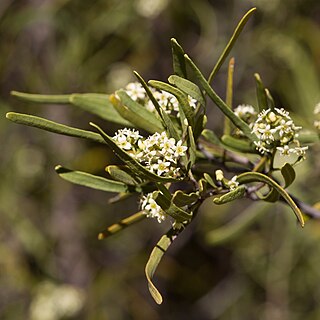
Geijera linearifolia, commonly known as oilbush or sheepbush, is a species of shrub in the family Rutaceae and is endemic to southern Australia. It has simple linear to oblong leaves, much-branched cymes of greenish-white flowers, and fruit containing a shiny black seed.

Pultenaea echinula, commonly known as curved bush-pea, is a species of flowering plant in the family Fabaceae and is endemic to a small area of New South Wales. It is an erect shrub with linear, needle-shaped, grooved leaves, and dense clusters of yellow to orange and red flowers.

Pultenaea euchila, commonly known as orange pultenaea, is a species of flowering plant in the family Fabaceae and is endemic to eastern Australia. It is an erect shrub with glabrous foliage, narrow egg-shaped leaves with the narrower end towards the base, and orange-coloured flowers arranged singly or in small groups near the ends of branchlets.
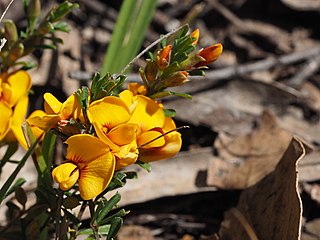
Pultenaea microphylla is a species of flowering plant in the family Fabaceae and is endemic to eastern Australia. It is an erect to prostrate shrub with narrow egg-shaped leaves with the narrower end towards the base, and clusters of up to ten yellow to red flowers with reddish markings.

Pultenaea spinosa, commonly known as grey bush-pea or spiny bush-pea, is a species of flowering plant in the family Fabaceae and is endemic to south-eastern continental Australia. It is a low-lying to erect shrub with glabrous stems, egg-shaped to rhombic leaves, and yellow-orange and red, pea-like flowers.

Pomaderris ligustrina, commonly known as privet pomaderris, is a species of flowering plant in the family Rhamnaceae and is endemic to south-eastern continental Australia. It is a shrub with hairy stems, lance-shaped to narrowly elliptic leaves, and loose clusters of cream-coloured or yellow flowers.

Cryptocarya cunninghamii, commonly known as Cunningham's laurel or coconut laurel, is a species of flowering plant in the laurel family and is endemic to northern Australia. It is a tree with oblong to elliptic leaves, the flowers creamy-green and tube-shaped, and the fruit a spherical black to purplish-blackdrupe.
Pimelea milliganii, commonly known as silver riceflower or Milligan's rice flower,is a species of flowering plant in the family Thymelaeaceae and is endemic to a restricted part of Tasmania. It is a low, much-branched, densely hairy shrub with more or less elliptic leaves and compact clusters of white to pinkish flowers usually surrounded by two leaf-like involucral bracts.

Pimelea umbratica, is a species of flowering plant in the family Thymelaeaceae and is endemic to eastern Australia. It is a shrub with densely hairy young stems, narrowly elliptic or more or less oblong leaves, and white flowers arranged singly, or in small groups, in leaf axils.

Acrotriche affinis, commonly known as ridged ground-berry or prickly honeypots, is a species of flowering plant in the family Ericaceae, and is endemic to south-eastern, continental Australia. It is an erect shrub with many branches, lance-shaped leaves, and spikes of tube-shaped, greenish flowers, and white, spherical drupes.



















